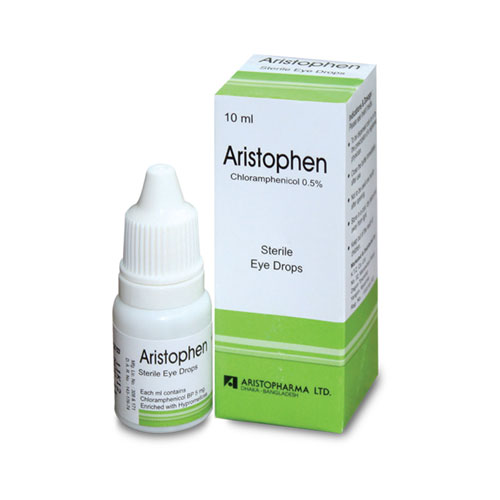
ARISTOPHEN Eye drops
Therapeutic Class
Antibiotic
Indications
Bacterial infections of the anterior segment of the eye (cornea, conjunctiva, uvea anterior), lids and tear ducts. Infection prophylaxis pre and post operatively, after chemical or other burns. Trachoma, herpes zoster ophthalmicus. For prophylactic and therapeutic irrigation of the tear ducts. Chloramphenicol is indicated if the infective agent is resistant to other antibiotics.
Chemical Composition
Each ml contains Chloramphenicol BP 5 mg.
Packaging
Each plastic dropper bottle contains 10 ml eye drops.
Dosage & Administration
Eye drops: Insert one drop into the conjunctival sac 2-4 times per day. In acute cases up to 1 drop every hour. In order to keep the systemic resorption as low as possible, the tear flow should be blocked by pressing with the finger on the side of the nose, near to the corner of the eye, for 1-2 minutes after instillation.
Contraindications
Hypersensitivity to the ingredients of this drug. Acute intermittent porphyria. Severe blood disorders and hepatic dysfunctions due to bone marrow depression. New-born babies. Family history of bone marrow depression.
Side Effects
Shortly after application a slight burning sensation and a bitter taste in the mouth may occur. Allergic reactions in the form of palpebral eczema have been reported in rare cases. Partially irreversible hematodyscrasia (aplastic anemia, pancytopenia, leukopenia, thrombocytopenia, agranulocytosis) has been observed in isolated cases following topical use of Chloramphenicol. However, the severity and the moment of manifestation of such partially irreversible and lethal effects did not correlate with the commonly elevated dosage used in these studies. Neuritis nervi after topical use of Chloramphenicol has been reported in isolated cases which recovered after discontinuation of the treatment.
Drug Interaction
Chloramphenicol should not be administered simultaneously with bactericidal substances (penicillins, cephalosporins, gentamicin, tetracyclines, polymyxin B, since bacteriostatic antibiotics may inhibit bactericidal antibiotics. Furthermore Chloramphenicol should not be administered at the same time as systemic treatment with drugs which have an adverse effect on hematopoiesis, nor simultaneously with sulphonylureas, coumarin derivatives, hydantoins and methotrexate (precautionary measured).

